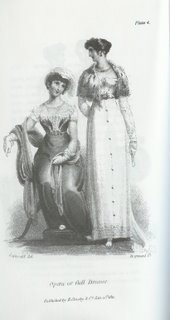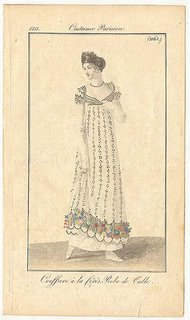
Having opened that nutshell, I don’t have the room for too many details. But as I was perusing two books this morning–one being REGENCY ETIQUETTE, The Mirror of Graces (1811) and THE FEMALE INSTRUCTOR (1831) it came home to me that there were prissy attitudes in dress and other attitudes in dress.
Regency affectionados sometimes believe there was just one way that things were–but most of us know that wasn’t so. Not to repeat myself (I may have said something along these lines before) but in the 60’s we did not wear Jackie Kennedy’s neat jacketed suits and pillbox hats, any more than we all wore mini-dresses in huge geometric prints. Or prairie dresses with flowers in our hair.
The lady (I assume both were ladies) author of REGENCY ETTIQUETTE had some amusing comments (not intending to be amusing, naturally). Here is one, regarding stays and corsets:
A vile taste in the contriver, and as stupid an approval by a large majority of women, have brought this monstrous distortion into a kind of fashion; and in consequence we see, in eight women out of ten, the hips squeezed into a circumference little more than the waist; and the bosom shoved up to the chin, making a sort of fleshy shelf, disgusting to the beholders, and certainly most incommodious to the bearer.
She has much to say on the subject of corsets, and also on the subject of a lady who, “of her own choice, ‘unveils her beauties to the sun and the moon.'” All of this suggests that there were ladies who wore stays and those who didn’t, and ladies who bared themselves in one way or the other–by means of low necklines or filmy material–and those who did not. Also, interestingly enough, the pictures published in this volume did not show examples of those you normally saw in women’s fashion publications in that year. The waistlines, for one, were almost at the normal waist and not high at all. (See the b & w scan above).
 The authoress of the 1834 volume has a similar opinion as the first. Immodesty and excess of dress are to be avoided, in her opinion, and “…do not be fools in order to be belles. Above all things consider decency and ease; never expose nor torture nature.” She also reiterated the first authoress’ opinion that one should dress appropriately to one’s station. It seems that even in 1811 there were concerns about girls of “plebian classes” dressing above their station.
The authoress of the 1834 volume has a similar opinion as the first. Immodesty and excess of dress are to be avoided, in her opinion, and “…do not be fools in order to be belles. Above all things consider decency and ease; never expose nor torture nature.” She also reiterated the first authoress’ opinion that one should dress appropriately to one’s station. It seems that even in 1811 there were concerns about girls of “plebian classes” dressing above their station.
The second scan is from Costume Parisienne of 1811.
The third is from Ackerman’s of that year (a mourning gown); the fourth is from Acerman’s, 1810, a ball gown.
Finally, the last lady is from Ackerman’s of 1812. I could not tell you which are the cit’s daughters and which are the peers!
Laurie




Laurie:
Your point is an excellent one, and one I wish people would keep in mind when they start wagging fingers. There is no one way things were done (unless they simply weren’t invented yet); people where I live where black most of the time (Cara rolls her eyes at me mentioning that YET AGAIN); people in more rural areas do not. And even when the people are in the same place–i.e. London–there must’ve been differences. One thing I always think about is that ladies must have worn their older dresses once in awhile, no? Maybe no, not if they only had one. But I know I’m still wearing clothing I wore in college, which was vintage when I bought it, so isn’t it just possible one of our heroines likes to color outside of the lines in her dress? So, yeah, there were different ways of doing things, just as there are now. Thank you, Laurie, for making that point.
Yes, I totally agree. People are not all alike nowadays, so why would we think they were all alike two hundred years ago? I lived through the late 70’s without having feathered hair, and I lived through the early 80’s without having big hair. Or designer jeans. Or Flashdance sweat shirts. Or leg warmers. 🙂
Cara
I read THE MIRROR OF THE GRACES a few years ago, and thought it was very amusing, as well as informative. In particular, I remember one remark of the author’s, which I will attempt to paraphrase from memory: “The divorce corset, like the legal divorce, attempts to separate that which should always remain together.” Very well put!
Todd-who-doesn’t-really-mind-beauties-being-unveiled-to-the-sun-and-the-moon
Good one Todd! My husband would wholeheartedly agree with you.
I purchased Mirror of the Graces by A Lady of Distinction last year and have only glanced through a few pages or so thus far. I liked the idea of it so much though, that I used a “mock-up” of it on the cover of my self-published Regency-set historical, entitled Unladylike Pursuits.
The point was that the heroine was content to set that volume aside and make her own rules… She was penning “Opportunities for Adventure by a Spinster of Daring.”
Alyssa
“a Spinster of Daring” — LOL, Alyssa! Sounds intriguing!
Cara